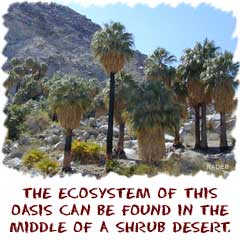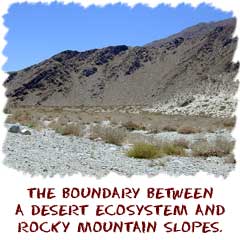 The word ecosystem is short for ecological systems. An ecosystem includes all of the living organisms in a specific area. These systems are the plants and animals interacting with their non-living environments (weather, Earth, Sun, soil, atmosphere). An ecosystem's development depends on the energy that moves in and out of that system. As far as the boundaries of an ecosystem, it depends upon how you use the term. You could have an entire ecosystem underneath a big rock. On the other hand, you could be talking about the overall ecosystem of the entire planet (biosphere).
The word ecosystem is short for ecological systems. An ecosystem includes all of the living organisms in a specific area. These systems are the plants and animals interacting with their non-living environments (weather, Earth, Sun, soil, atmosphere). An ecosystem's development depends on the energy that moves in and out of that system. As far as the boundaries of an ecosystem, it depends upon how you use the term. You could have an entire ecosystem underneath a big rock. On the other hand, you could be talking about the overall ecosystem of the entire planet (biosphere). An ecosystem can be as small as a puddle or as large as the Pacific Ocean. That ecosystem includes every living and non-living thing in the area. It is several small communities interacting with each other.
Let's look at a puddle example. You might start by looking at the temperature, depth, turbulence, sunlight, atmospheric pressure, weather patterns, wind, nutrients, etc. Those are just the non-living things in the ecosystem of a puddle. When you add on all the living interactions, you have a good idea how complex an ecosystem can be. Even a puddle is an amazing place.
Biomes
Scientists discuss some general ecosystem types. They call them biomes. A biome is a large area on the Earth's surface that is defined by the types of animals and plants living there. A biome can be partially defined by the local climate patterns. You may also have more than one type of biome within a larger climate zone. Here is a short list of possible biomes.- Tropical Rainforest (Think about Brazil)
- Tropical Savanna (Think about Africa)
- Desert (Think about the middle east)
- Mediterranean Woodland (Think about coniferous forests)
- Mid-latitude Grassland (Think about Oklahoma)
- Mid-latitude Deciduous Forest (Think about the east coast of North America)
- Tundra (Think about frozen plains of Alaska)
- Ice Caps (Think about the poles)









0 comments:
Post a Comment